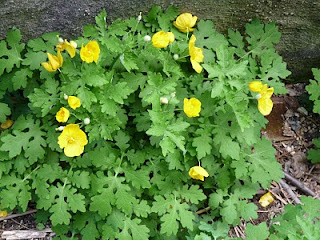





There are some plants that are just too beautiful to not grow, but they need to be watched, for they would conquer the world, if allowed. Stylophorum diphyllum is a native plant which seeds around freely, very freely indeed. The sumptious yellow poppy like flowers are gorgeous, though, and the attractively cut leaves are not without merit either. It is either too happy or not happy at all, mine seems to have found a position to its liking, in rich soil in a shaded position between a yew and the neighbor's wall. It was not so happy in drier soil with lots of competition where I originally planted it.
Corydalis ochroleuca is another prolific self seeder, favoring partially shaded areas, with a particular ability to grow in crevices such as cracks in stone walls. Like the stylophorum, seeds are ejected so they travel for a distance from the parent plant. They germinate en masse the following spring, and quickly grow to flowering size. This plant flowers constantly, from early spring till early winter, with peaks during cool weather. Like stylophorum, exess seedlings are easy to remove but somewhat touchy about being transplanted.
Lamium galeobdolon is a wonderful groundcover for difficult dry shady places with tree root issues. It has beautifully patterned foliage which persists in winter, and for a short time in midspring, lovely masses of soft yellow flowers complete a beautiful picture. So what's not to like--well, it does send out rapidly growing runners that root at each leaf node, and are not particularly easy to pull up once they have a good foothold. Note that the supposed cultiver "Herman's Pride" is a totally different plant, a clumping perennial rather than a running groundcover, and is well behaved--I can't believe it is the same species (and don't, actually).
Of similar disposition to the normal form of L. galeobdolon is Ranunculus repens "flore pleno", the double creeping buttercup. I got my start decades ago from the Brooklyn Botanic Garden when I worked there one summer as an urban gardening intern, and its been with me ever since. I have a particular fondness for double buttercups, and grow a few other kinds, but this one is the only one that could be called rambunctious, for it is an aggressive spreader, much in the same manner as strawberry plants are. It blooms once in mid to late spring over a few weeks, then promptly sends out stolons in all directions. Periodically I go on a rampage to get rid of most of it, but the few plants left behind always repopulate their allocated area quickly, and I am thankful when the perfectly formed double flowers appear each spring. I recently set some loose in the slope garden at school, where they formed a nice mass of bloom as seen in the pic. No doubt I will be snipping off stolons all summer long.
All of these make fine garden plants, but with the caveat that they must be actively managed, or they will run over lesser neighbors. On the other hand, they tend to be great plants for tough sites where little else will grow, except, perhaps, for the stylophorum, which does like good "forest floor" type soil and decent moisture.
No comments:
Post a Comment